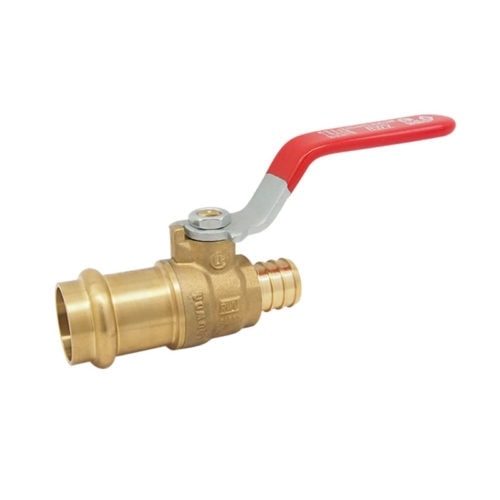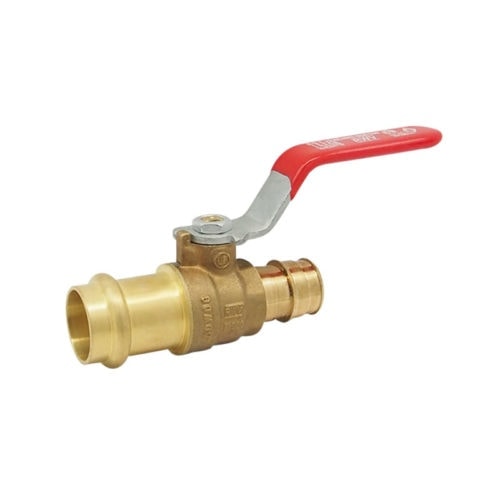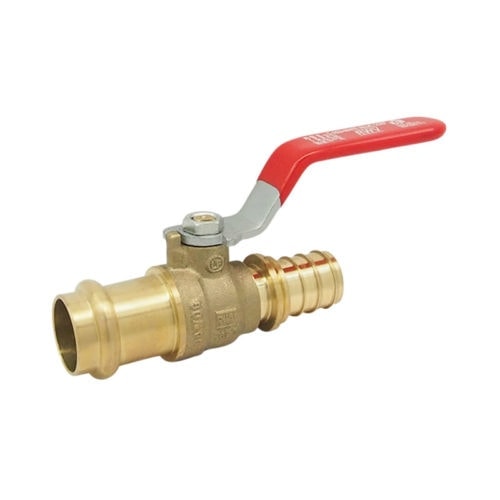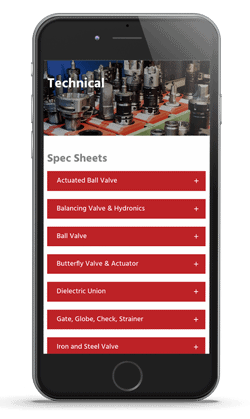PEX valves refer to valves designed to connect with tubing and piping made from cross-linked polyethylene (PEX). The main difference between them and regular valves is how the connections are made; PEX valves connect to PEX tubing and piping without the use of transition adapters. Other than this distinction, the two are highly similar, making them suitable for many of the same applications. Typical uses for PEX valves include shut-off, maintenance, and repair operations.
The type of polyethylene used for PEX valve tubing and piping is cross linked polyethylene. It has tightly packed polymers, which results in some characteristics that are very good for plumbing and hyfronic applications. The cross-linking process enhances or adds certain properties that make the material better suited for plumbing components. It can be performed in three ways: A, B, and C. Each involves distinct techniques and/or technologies, which results in different material characteristics. Below, we highlight the differences between the three types of PEX production methods.
PEX A vs. PEX B vs. PEX C Valve Tubing/Piping Material
PEX tubing and piping components are available in three main varieties: PEX A, PEX B, and PEX C. While this naming convention may seem like the products are graded from best to worst, it actually refers to how their materials are made.
- PEX A: These materials are cross-linked using the Engel process, which involves the introduction of peroxides to the HDPE before it is formed. The addition of the compounds allows for more bonding at the atomic level, resulting in the highest degree of cross-linking. The processed material offers the greatest flexibility and kink resistance of all PEX materials.
- PEX B: These materials are cross-linked using the silane process, which is also commonly referred to as steam or moisture cross-linking. This process is performed on the HDPE material after it has been formed. By passing the formed component through steam in the presence of a silane-based catalyst, the polymers are encouraged to form cross-links. The processed material is not expandable and the least resistant to kinks.
- PEX C: These materials are not as common as PEX A and PEX B. The cross-linking process involves subjecting the HDPE material to an electron beam or gamma radiation.
In addition to their unique characteristics, PEX A, PEX B, and PEX C have some shared properties. For example:
- They exhibit enough flexibility for use in plumbing components.
- They offer resistance to corrosion.
- They meet ASTM standards.
- They accommodate use in potable water applications (if NSF-certified).
PEX Valve Connection Types
PEX valves can have a variety of connection types. Each has unique instructions on how the valve must be connected to the tubing or piping.
PEX valves from RED-WHITE VALVE CORP. are available with the following connection types:
 F-1807
F-1807
PEX F1807 valve connections are manufactured according to the ASTM F1807 standard. Proper installation of these valves requires an appropriate crimp ring and PEX tube/pipe. The installation process is as follows:
- The crimp ring is slid over the end of the tubing/piping.
- If installing a tailpiece, the union nut is mounted over the tailpiece before it is connected to the tube/pipe.
- The valve is pushed into the end of the tubing/piping until it stops.
- The crimp ring is positioned 1/8 to 1/4 inch away from the end of the tubing/piping and over the ribs of the valve.
- The crimp ring is crimped using a crimping tool.
- The crimp is checked using a gauge.
 F-1960
F-1960
PEX F1960 valve connections are manufactured according to the ASTM F1960 standard. Proper installation of these valves requires an appropriate ring and PEX tube/pipe. The installation process is as follows:
- The ring is slid onto the PEX tube/pipe.
- If installing a tailpiece, the union nut is mounted over the tailpiece before it is connected to the tube/pipe.
- The PEX tubing/piping and ring are expanded using an expander tool.
- The expanded assembly is inserted onto the PEX valve.
 EVERLOC+
EVERLOC+
REAHU Everloc+® valve connections are manufactured according to the REHAU EVERLOC+® patented system. Proper installation of valves with EVERLOC+® compression-sleeve connections requires EVERLOC+® PEXa compression sleeves and REHAU PEXa tubes/pipes. Installation operations should only be performed with EVERLOC+® compression-sleeve tools.
PEX Valves at RED-WHITE VALVE CORP.
Want to learn more about PEX valves? The valve experts at RED-WHITE VALVE CORP. are here to help! As a premier supplier of high-quality valves for the plumbing, commercial, industrial, and HVAC markets, including PEX valves, we can answer and address any questions or concerns you may have about the components. Additionally, if you need PEX valves for your operations, we can help you identify and source the right solution for your needs.
Our PEX valve offerings include:
- Ball valves
- Transition ball valves
- Ball valves with drains
- Ball valves with mounting foot
- Ball valves with drains and mounting foot
To learn more about our products, check out our PEX valve catalog or contact us today.

